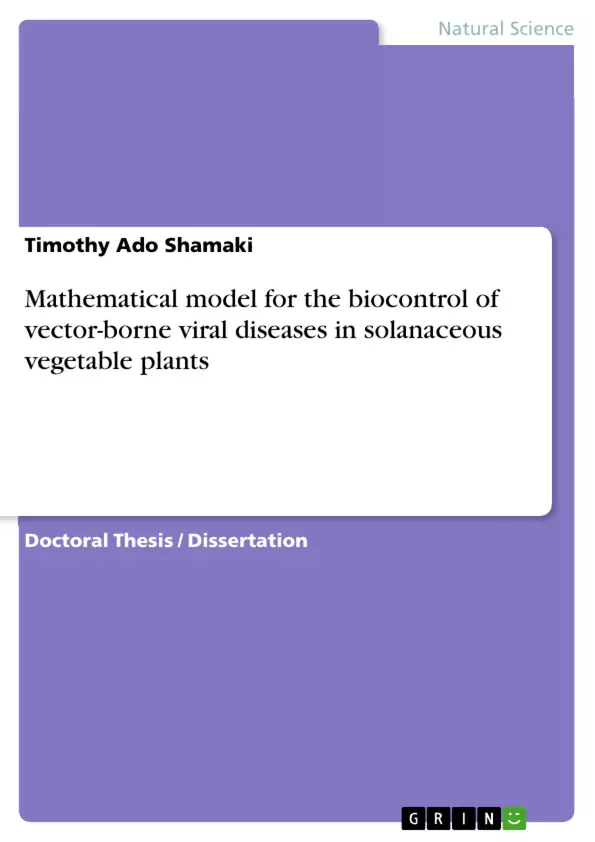This thesis treats the issue of Vector-Borne Virus Diseases (VBVDs) that are transmitted in solanaceous vegetable plants by incorporating three species of vectors (aphids, thrips and whiteflies). A mathematical model was developed that used lady beetles as biological control agents for controlling the spread of diseases in solanaceous vegetable plants through predation. The research adopted the linearization method.
This research is restricted to a biological control of VBVDs of solanaceous vegetable plants using compartmental modeling approach. The model is a system of first order nonlinear ODEs. Additionally, the study is limited to three solanaceous plants (i.e. tomato, pepper and eggplant). This is because solanaceous plants are among the world's most cultivated crops and given proper conditions and regular maintenance, they are relatively easy to grow. We focused on viral diseases that affect solanaceous vegetable plants especially Yellow Leaf Curl Virus (YLCV), Spotted Wilt Virus (SWV) and Cucumber Mosaic Virus (CMV).
It is a common knowledge that these plant viruses also require some sort of carrier, known as vectors to transmit the pathogen from plant to plant. Therefore, the study is demarcated to a class of aphids (green peach aphids), thrips (T. tabasi) and whiteflies (Bemisia tabasi) because these ones are reported as the common problem associated with solanaceous plants which can be controlled by natural predatory enemies - ladybugs (hippodamia convergens).
Inhaltsverzeichnis (Table of Contents)
-
CHAPTER ONE: INTRODUCTION
- 1.1 Background of the Study
- 1.2 Statement of the Problem
- 1.3 Objectives of the Study
- 1.4 Scope of the Study
- 1.5 Significance of the Study
- 1.6 Research Questions
- 1.7 Literature Review
- 1.8 Conceptual Framework
-
CHAPTER TWO: MODEL DEVELOPMENT
- 2.1 Model Assumptions
- 2.2 Model Formulation
- 2.3 Model Analysis
-
CHAPTER THREE: MODEL SIMULATION AND RESULTS
- 3.1 Numerical Methods
- 3.2 Simulation Results
-
CHAPTER FOUR: DISCUSSION OF RESULTS
- 4.1 Sensitivity Analysis
- 4.2 Model Validation
- 4.3 Discussion of Results
-
CHAPTER FIVE: CONCLUSION AND RECOMMENDATION
- 5.1 Conclusion
- 5.2 Recommendations
Zielsetzung und Themenschwerpunkte (Objectives and Key Themes)
This PhD thesis explores the development and analysis of a mathematical model for the biocontrol of vector-borne viral diseases (VBVDs) in Solanaceous vegetable plants. The primary goal is to investigate the effectiveness of biocontrol strategies in mitigating the spread of these diseases. This study aims to contribute to a deeper understanding of the dynamics of VBVDs and provide valuable insights for the development of sustainable control measures.
- Mathematical Modeling of VBVD Dynamics
- Biocontrol Strategies for VBVDs
- Sensitivity Analysis of Model Parameters
- Model Validation and Application
- Sustainable Control Measures for VBVDs
Zusammenfassung der Kapitel (Chapter Summaries)
The initial chapter provides a comprehensive overview of the research, including the background, problem statement, objectives, scope, significance, research questions, literature review, and conceptual framework. This lays the foundation for the subsequent chapters. Chapter two delves into the development of the mathematical model, outlining the model assumptions, formulation, and analysis. This section provides a detailed explanation of the theoretical basis of the model. Chapter three focuses on the simulation and results obtained from the developed model. It discusses the numerical methods employed and presents the findings from the simulations. Chapter four examines the sensitivity analysis, model validation, and overall discussion of the results, providing insights into the effectiveness and applicability of the model.
Schlüsselwörter (Keywords)
This research utilizes key terms such as vector-borne viral diseases, Solanaceous vegetable plants, biocontrol, mathematical modeling, model analysis, sensitivity analysis, model validation, sustainable control measures, and disease dynamics.
- Citation du texte
- Timothy Ado Shamaki (Auteur), 2022, Mathematical model for the biocontrol of vector-borne viral diseases in solanaceous vegetable plants, Munich, GRIN Verlag, https://www.grin.com/document/1320768



